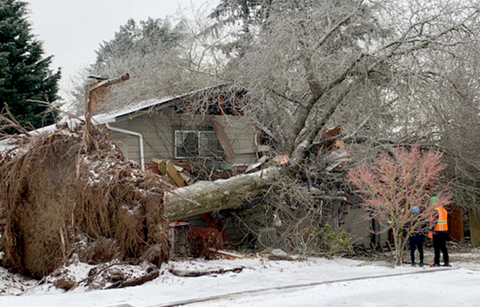What can we do to prevent power outages?

By Virginia Bruce
During late December and early January, high winds and prolific precipitation put stress on large trees in the area, resulting in branches and entire trees falling on power lines and causing frequent and sometimes widespread power outages. We talked to PGE and local arborists to find out if there were steps we could take to mitigate the danger.

Andrea Platt, PGE Communications, shares the PGE web page on tree maintenance, outlining PGE’s approach to tree safety and maintenance. She says, “It includes good guidance on planting the right trees in the right place, what PGE maintains and manages, and what homeowners can do for safety’s sake when it comes to planting and pruning trees.”
We asked if there was any effort to put more lines underground. She responded, “About half of PGE’s power lines are already underground. We are always evaluating where additional undergrounding could help mitigate risks, while balancing this with the impact to customer prices. There’s no single solution to protect power lines from the effects of climate change and the extreme weather events we are seeing in Oregon. For example, storms can cause trees to uproot, which can uproot buried electrical lines. Buried lines can also experience outages that are more difficult and time-consuming to repair—impacting the duration of an outage. Retrofitting established neighborhoods can be extremely complex given other systems that are underground and other factors. PGE is judicious about expenses that will ultimately impact customer prices.”
We wondered about the causes of the large outage on December 26. “It’s very difficult to pinpoint a single cause/issue for the outages in that zip code. Generally, the soil in our service area was saturated by the earlier ice and rain, and heavy rains that began on December 26 added even more moisture—taking down limbs and causing debris to hit our lines and equipment. Saturated soil can become mud, and wind adds movement—all factors that created a recipe for trees to uproot and fall or lean on our equipment. The wind and weather that moved through also featured strong southerly winds, which we don’t usually see in our service area. Trees develop roots based on the conditions they grow in, so when those conditions change, the tree may be more susceptible to failure.”
“Even still, PGE appreciates that the succession of storms impacted some customers more than once, and that any outage can be quite challenging. We appreciated our customers’ patience as PGE, contractors, and out of state crews worked to address more than 235,000 individual outages that occurred in the last week of December.”
“In the video on ‘managing trees near power lines’ we cover how PGE foresters go out every two to three years to assess and trim trees where needed to help keep our lines clear. While the best approach is for folks to plant the right trees in the right place, if residents see a potentially hazardous situation, they should call PGE at 503-736-5460.”
Jeff Jazwinski, Badger Tree Service, shared more information with us. We asked if neighbors would be able to spot a tree in trouble. “A trained eye can spot an unhealthy tree. Conks (a fungus that grows out of a tree trunk) are a sign, either up on the trunk even if the bottom looks healthy, or around the bottom. Holes in the tree from a woodpecker, or a rotten spot on the trunk are other signs to look for.”
“Saturated soil and the high winds we’ve had have led to a lot of trees falling. Sometimes if a big tree at the edge of a grove falls, the inner trees haven’t developed strong roots from the wind stress, and they will go next. Also, trees removed for development can lead to nearby trees being too weak. Larger evergreens might have dead branches on the shaded side. Look for few or no needles. The best time to do that is at the end of summer. You can spot dead areas before all the leaves fall off.” He said that it’s not often that you can see a tree about to fall, it’s hard to see anything on the surface of the soil.
Jeff mentioned that if you have tall evergreens, some thinning of the upper branches to open up space to allow wind to pass through is beneficial. Other arborists differ on the efficacy of thinning.
Treekeepers of Washington County offers this information in their February newsletter:
Our recent wind storms took a big toll on area trees, and many homeowners are nervous about their own trees. The fate of one tree does not determine the fate of a neighboring tree however, as many factors are involved. Arborist Will Koomjian of Emergent Tree Works asserts, “The overall risk posed by trees is incredibly low, but there are ways to identify and mitigate that risk.”
If you are worried about your trees, the best course of action is to have them inspected by an arborist with a Tree Risk Assessment Qualification from the The International Society of Arboriculture (ISA). Identifying tree risk before and after a storm allows for measures that can reduce risk while preserving trees that have an acceptable level of risk.
Taking regular steps to ensure your trees’ continuing health is also important. Water deeply but infrequently during summer drought. Mulch to maintain moisture. Prune as needed for good structure. Winter is a great time to prune, as we explain in this article.
You can find a list of some trusted arborists on our website. The ISA website also manages an educational website that contains quality tree care information for homeowners, including suggestions for Recognizing Tree Risk and Storm Storm-related Tree Damage.
So give your tree a hug for surviving the latest storms, and thank it for the many benefits it continues to provide!





